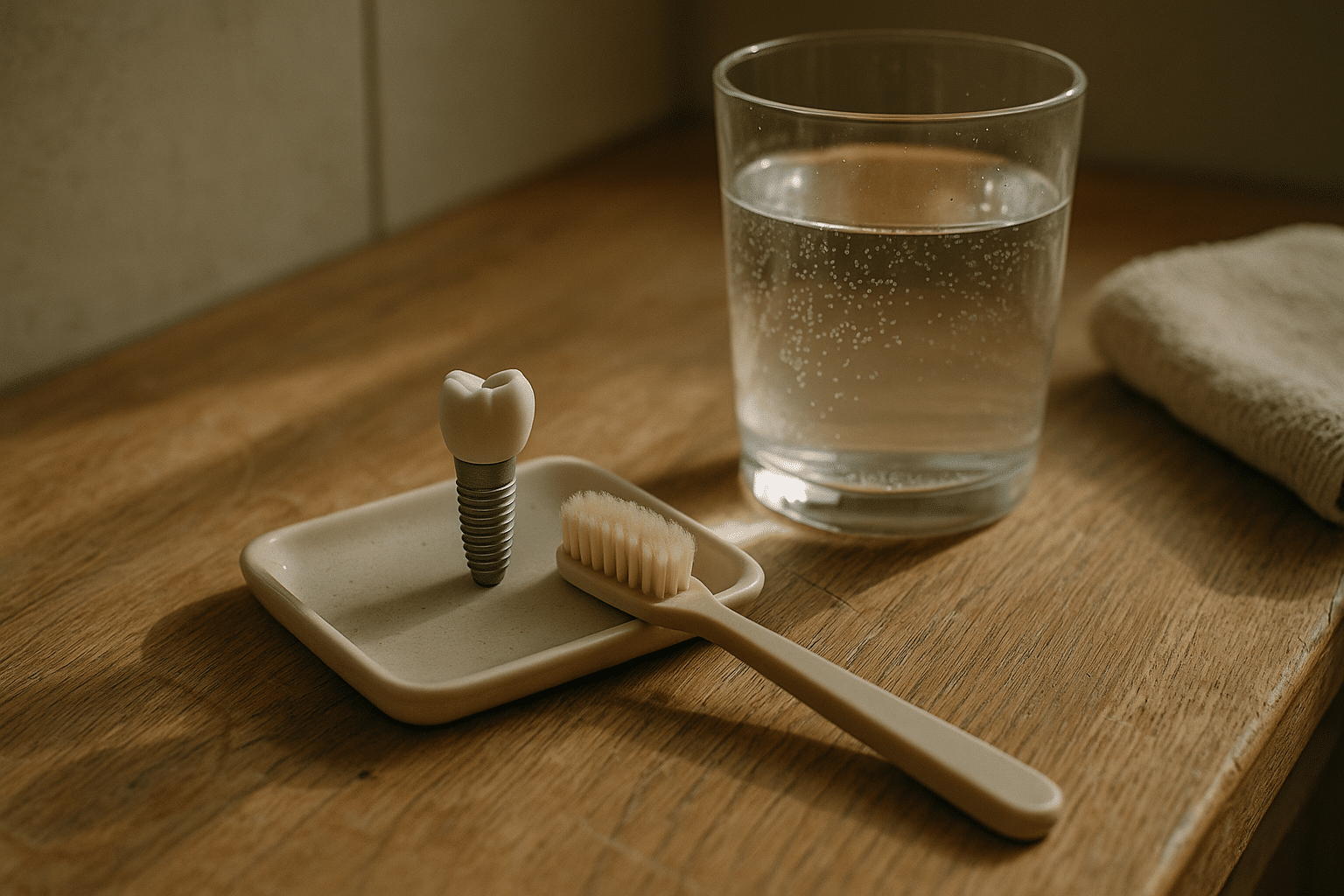
A Practical Guide to Dental Implants: Benefits, Longevity, and Care
A Practical Roadmap to Dental Implants
Dental implants replace missing teeth with a small post anchored in the jawbone that supports a crown, bridge, or denture. This guide explains what implants are and how the process unfolds from evaluation through restoration. You’ll also find a clear look at the advantages implants can offer for everyday comfort and function, along with realistic expectations about how long they last. Finally, we’ll cover day-to-day and long-term care so you know exactly how to look after implants and protect your investment in your smile.
Introduction: Why Dental Implants Matter
Missing teeth do more than leave a gap in a smile—they can change how we chew, speak, and even how our jawbone ages. For many adults, dental implants are a practical way to restore confidence and function without relying on removable appliances. Because the topic brings together surgery, materials science, and daily self-care, it helps to have a single, plain‑language overview that connects the dots. Think of this article as your map: what implants are, why people choose them, how long they can serve you, and what to do each day to keep them healthy.
Dental Implants 101: What They Are, How They’re Placed, and Who’s a Candidate
What is an implant? A dental implant is a biocompatible post—most commonly titanium—placed in the jawbone to act like a tooth root. Once your bone heals firmly around it (a process known as osseointegration), an abutment connects the post to a custom crown. Implants can also anchor bridges and stabilize full or partial dentures.
Core components:
- Implant post (root replacement placed in bone)
- Abutment (connector above the gumline)
- Restoration (crown, bridge, or denture)
The typical sequence: evaluation and 3D imaging; any preparatory care (for example, removing a hopeless tooth or treating gum inflammation); placement of the implant post; healing and integration; then placement of the abutment and final crown. Timelines vary: some cases are restored the same day with a provisional tooth, while others benefit from a staged approach to allow bone and gum to mature.
Who’s a good candidate? People in stable general health with healthy gums and adequate bone tend to do well. If bone volume is limited, your dental team may discuss grafting options. Conditions like poorly controlled diabetes or heavy smoking can complicate healing; they don’t automatically rule out implants, but they call for tailored planning and close coordination with your dentist and physician.
Materials and designs: Titanium implants are widely used because of their long track record in the mouth and beyond. Ceramic (zirconia) implants exist as a metal‑free alternative; some patients choose them for personal preferences or specific clinical situations. Implants also differ in shape (tapered vs. cylindrical) and surface texture; your clinician chooses based on your anatomy and goals.
What to expect after surgery: Mild swelling or soreness is common for a few days. Soft, cool foods, careful hygiene around the site, and following the post‑op instructions you receive help promote uneventful healing. You’ll return for follow‑ups to confirm stability before the final restoration is fitted.
Everyday reality check: Dental implants are not maintenance‑free. They need the same thoughtful brushing, cleaning between teeth, and professional checkups that natural teeth do—plus a few targeted tools and techniques. We’ll cover those in detail below.
The Benefits of Dental Implants (Backed by Real‑World Evidence)
Implants are chosen for practical, day‑to‑day advantages—chewing comfortably, speaking clearly, and smiling without worry. As the American Dental Association’s consumer site notes, implants are “a popular and effective way to replace missing teeth,” designed to blend in with the rest of your smile. ([mouthhealthy.org](https://www.mouthhealthy.org/all-topics-a-z/implants?utm_source=openai))
Function and comfort you can feel
- Chewing efficiency: Because the implant is anchored in bone, it can transmit bite forces more like a natural tooth, which often translates into confident chewing across a wider range of foods. Cleveland Clinic highlights improved chewing and speech among the practical gains people notice. ([my.clevelandclinic.org](https://my.clevelandclinic.org/health/treatments/10903-dental-implants?utm_source=openai))
- Speech clarity: Stable teeth reduce the “click” or shift removable dentures can cause when you talk. ([my.clevelandclinic.org](https://my.clevelandclinic.org/health/treatments/10903-dental-implants?utm_source=openai))
- Stability for dentures: Two to four implants can secure a lower denture dramatically, reducing movement and sore spots. ([my.clevelandclinic.org](https://my.clevelandclinic.org/health/treatments/10903-dental-implants?utm_source=openai))
Structural and health‑related benefits
- Bone preservation: When a tooth is lost, the surrounding bone can shrink over time. Implants help the jaw bear functional loads again; Mayo Clinic underscores the solid support created as bone heals around the implant. ([mayoclinic.org](https://www.mayoclinic.org/tests-procedures/dental-implant-surgery/about/pac-20384622?utm_source=openai))
- Conserving neighboring teeth: A single‑tooth implant usually does not require reshaping the adjacent teeth, unlike a traditional bridge. Cleveland Clinic explains this “one‑tooth solution to a one‑tooth problem” approach. ([my.clevelandclinic.org](https://my.clevelandclinic.org/health/treatments/10903-dental-implants?utm_source=openai))
A quick comparison to other options
| Feature | Implant + Crown | Fixed Bridge | Removable Partial/Full Denture |
|---|---|---|---|
| Chewing stability | Anchored in bone; typically very stable. ([mayoclinic.org](https://www.mayoclinic.org/tests-procedures/dental-implant-surgery/about/pac-20384622?utm_source=openai), [my.clevelandclinic.org](https://my.clevelandclinic.org/health/treatments/10903-dental-implants?utm_source=openai)) | Stable when well‑fitted; relies on adjacent teeth. | Can move; adhesives sometimes needed. |
| Effect on nearby teeth | Usually none; no reshaping needed. ([my.clevelandclinic.org](https://my.clevelandclinic.org/health/treatments/10903-dental-implants?utm_source=openai)) | Requires reshaping support teeth. | No tooth reshaping; clasps may stress abutment teeth. |
| Bone preservation at site | Helps maintain stimulation of bone. ([mayoclinic.org](https://www.mayoclinic.org/tests-procedures/dental-implant-surgery/about/pac-20384622?utm_source=openai)) | Does not stimulate bone at the missing‑tooth site. | Does not stimulate bone; ridge can change over time. |
| Longevity potential | Implant can last decades with care; crown may be replaced over time. ([my.clevelandclinic.org](https://my.clevelandclinic.org/health/treatments/10903-dental-implants?utm_source=openai)) | Typically 10–15 years with care. | Relines/repairs common; replacement intervals vary. |
| Daily cleaning | Toothbrush + interdental tools around implant. | Toothbrush + floss threaders/superfloss under pontic. | Remove and clean appliance thoroughly. |
| Speech | Feels similar to a natural tooth. ([my.clevelandclinic.org](https://my.clevelandclinic.org/health/treatments/10903-dental-implants?utm_source=openai)) | Generally good once adapted. | May affect speech until adapted. |
| Comfort | Fixed; no acrylic covering palate or floor of mouth. | Fixed; natural feel for many. | Bulkier; tissue‑supported in part or full. |
| Up‑front investment | Higher initially; long‑term value when maintained. (Discuss specifics with your dentist.) | Moderate; involves neighboring teeth. | Often lower initially; maintenance/replacement add up. |
Choosing a qualified provider makes a difference. You can use the ADA’s public directory to search for a dentist near you or visit the American Academy of Implant Dentistry’s patient site to learn about credentials and find implant-focused care. ([findadentist.ada.org](https://findadentist.ada.org//?utm_source=openai), [aaid.com](https://www.aaid.com/for-patients?utm_source=openai))
If you’re weighing options or budgeting, you might also bookmark our complete guide to cost and insurance questions for restorative dentistry.
How Long Do Implants Last—and How to Care for Them Day to Day
Longevity in perspective. With routine dental care and healthy habits, implants can serve for many years. Cleveland Clinic reports an overall expectation that, with proper hygiene and regular visits, implants may last a lifetime, while the crown on top typically needs periodic replacement over time (often around the 10–15‑year mark, depending on wear). ([my.clevelandclinic.org](https://my.clevelandclinic.org/health/treatments/10903-dental-implants?utm_source=openai)) Moreover, very long‑term data exist: an ADA summary of a 38–40‑year follow‑up found single‑tooth implants showed high survival, even though some crowns were replaced along the way—underscoring the difference between the implant itself and the restoration attached to it. ([adanews.ada.org](https://adanews.ada.org/huddles/40-year-prognosis-of-single-tooth-dental-implants/?utm_source=openai))
What affects lifespan? Daily plaque control, regular professional cleanings, and risk‑factor management (for example, smoking cessation and diabetes control) all matter. Mayo Clinic’s guidance emphasizes meticulous home care, scheduled checkups, and avoiding habits that can damage restorations, like crunching ice. ([mayoclinic.org](https://www.mayoclinic.org/tests-procedures/dental-implant-surgery/about/pac-20384622?utm_source=openai)) Centers that publish outcomes, such as Cleveland Clinic, report success rates around 95% for implant integration in recent years, reflecting how established the therapy has become when planned and maintained well. ([my.clevelandclinic.org](https://my.clevelandclinic.org/departments/head-neck/outcomes/355-dental-implant-success-rate?utm_source=openai))
Care routine you can follow
- Brush twice daily with a soft‑bristle manual or powered brush. Consider a high‑quality electric brush such as the Oral‑B iO Series or a Philips Sonicare model; both are widely used in implant patients and reviewed favorably by independent publications like Wirecutter’s electric toothbrush guide.
- Clean between teeth and around the implant: interdental brushes (for example, TePe interdental brushes) or specialty floss help access the contour where plaque collects.
- Add a water flosser if recommended by your dental hygienist; many patients like the countertop Waterpik Aquarius WP‑660 to irrigate around implants and bridges.
- See your dental team at intervals they recommend (often 3–6 months) for professional cleanings and periodic X‑rays to monitor bone and components. ([mayoclinic.org](https://www.mayoclinic.org/tests-procedures/dental-implant-surgery/about/pac-20384622?utm_source=openai))
- Protect your work: avoid chewing hard objects, wear a nightguard if you clench or grind, and use a mouthguard for contact sports. ([mayoclinic.org](https://www.mayoclinic.org/tests-procedures/dental-implant-surgery/about/pac-20384622?utm_source=openai))
Early days after surgery. Your surgeon’s instructions come first. Many hospitals and specialty centers advise soft foods at first, gentle brushing away from the surgical site, and short‑term use of an antimicrobial rinse if prescribed. Guidance from UK hospital services, for example, recommends avoiding brushing right over the surgical area for roughly a week and using a chlorhexidine rinse as directed in the immediate post‑operative period. ([guysandstthomas.nhs.uk](https://www.guysandstthomas.nhs.uk/health-information/dental-implants/after-having-dental-implant?utm_source=openai))
A quick note on materials and expectations. While titanium implants have an extensive track record, research summaries have reported lower five‑year survival in certain custom zirconia designs; your dentist will discuss whether ceramic implants fit your situation. ([adanews.ada.org](https://adanews.ada.org/huddles/five-year-outcomes-in-custom-zirconia-dental-implants/?utm_source=openai))
Real‑life example: Miguel, a 52‑year‑old teacher, had a lower molar implant placed three years ago after a fracture. He switched to a powered brush, added an interdental brush for the sides of the implant, and set 6‑month cleanings on his calendar. The crown needed a minor bite adjustment at his first follow‑up, and he now chews comfortably on both sides—proof that small, consistent habits support long‑term success.
At‑a‑glance care planner
| Task | How Often | What to Use | Why It Matters |
|---|---|---|---|
| Brush around implants | 2× daily | Soft brush or reputable electric brush | Removes sticky plaque before it hardens |
| Clean between teeth/implant | Daily | Interdental brushes, specialty floss | Targets the curve where plaque collects |
| Water flossing | Daily or as advised | Countertop or cordless irrigator | Helps flush food debris around contours |
| Antimicrobial rinse (post‑op only) | Short term, as prescribed | Chlorhexidine or surgeon‑directed product | Supports early healing when brushing is limited. ([guysandstthomas.nhs.uk](https://www.guysandstthomas.nhs.uk/health-information/dental-implants/after-having-dental-implant?utm_source=openai)) |
| Professional cleanings | Every 3–6 months | Hygiene visit with implant‑safe instruments | Disrupts mature biofilm; checks components. ([mayoclinic.org](https://www.mayoclinic.org/tests-procedures/dental-implant-surgery/about/pac-20384622?utm_source=openai)) |
| X‑rays | As recommended | Periapical or bitewing radiographs | Monitors bone support around implant |
| Nightguard (if grinding) | Nightly | Custom guard from your dentist | Reduces overload on implant and teeth |
| Habits check | Ongoing | Awareness: avoid ice, pens, hard candy | Prevents chipping or loosening. ([mayoclinic.org](https://www.mayoclinic.org/tests-procedures/dental-implant-surgery/about/pac-20384622?utm_source=openai)) |
Where to learn more or get help: See the ADA’s overview for patients on what to expect with implants, and if you’re choosing a provider, compare local options via ADA Find‑a‑Dentist and the AAID’s patient resources. ([mouthhealthy.org](https://www.mouthhealthy.org/all-topics-a-z/implants?utm_source=openai), [findadentist.ada.org](https://findadentist.ada.org//?utm_source=openai), [aaid.com](https://www.aaid.com/for-patients?utm_source=openai))
Frequently Asked Questions
How long does it take to get an implant?
Simple cases can be restored in a few months; others take longer if bone grafting or staged healing is recommended. Your dentist will outline a personalized timeline.
Will an implant look like a real tooth?
Modern crowns are matched for color and shape to blend with your smile. The implant itself sits in bone; the visible part is the custom restoration.
Do implants set off airport scanners?
Dental implants typically do not cause issues with security scanners. If you have multiple implants or extensive metal work, you can mention it to security if asked.
What if I clench or grind my teeth?
Tell your dentist. A custom nightguard can reduce excessive force on implants and natural teeth, helping protect your restorations.
Are ceramic (zirconia) implants an option?
They exist and may be considered in select cases, but some reports have noted lower survival in certain designs. Discuss pros and cons for your specific needs. ([adanews.ada.org](https://adanews.ada.org/huddles/five-year-outcomes-in-custom-zirconia-dental-implants/?utm_source=openai))
Quick resource list (external): Practical overviews from ADA MouthHealthy, Cleveland Clinic’s implant guide, and Mayo Clinic’s implant surgery page are helpful next reads. ([mouthhealthy.org](https://www.mouthhealthy.org/all-topics-a-z/implants?utm_source=openai), [my.clevelandclinic.org](https://my.clevelandclinic.org/health/treatments/10903-dental-implants?utm_source=openai), [mayoclinic.org](https://www.mayoclinic.org/tests-procedures/dental-implant-surgery/about/pac-20384622?utm_source=openai))
Conclusion: Keep It Simple—and Consistent
Dental implants can restore day‑to‑day comfort and confidence with a solution that feels natural and stays put. Their long service life depends on the same fundamentals that protect natural teeth: daily plaque control, smart habits, and regular check‑ins with your dental team. If you’re considering implants, start with a thorough consultation, ask about experience and materials, and map out a maintenance plan you’ll actually follow. Small steps, done consistently, help your implants—and your smile—go the distance.


